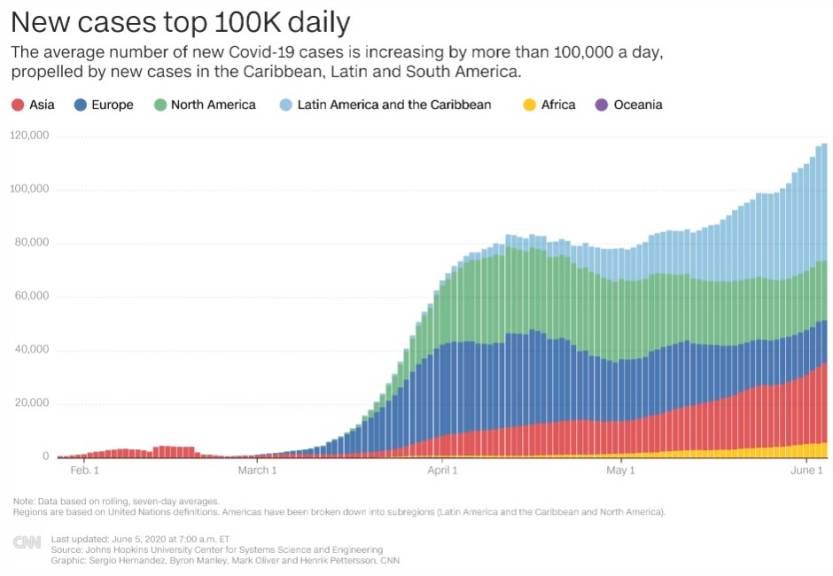The Number Of New Coronavirus Cases Is Rising Faster Than Ever
- The map of the coronavirus spread shows that transmission is worsening globally, even though regions in Europe and the US have started reopening their economies after "flattening the curve."
- More than 100,000 new COVID-19 cases around the world have been registered nearly every day since May 21st.
- The Americas account for most cases, with Brazil becoming the new epicenter of the disease according to recent figures.
New York City has gone a full day without reporting a death caused by the novel coronavirus, and that's great news for the former COVID-19 epicenter of the world. We've seen similar good news from Europe and other regions that were able to flatten the curve. But while some countries and US states are in the process of reopening their economies, it's worth pointing out that the novel coronavirus threat is still out there. In fact, the number of newly confirmed coronavirus cases is rising faster than ever, fueled by regions that have been seeing massive growth in the past few days. Brazil is the new epicenter of the disease, but it's hardly the only country experiencing an increased number of cases. That's an important detail because of the way the global economy actually works. Opening up local economies won't be enough if specific sectors remain affected by the virus. If regions of the world are dealing with surges in COVID-19 cases as other nations reopen, for example, then travel and tourism will be significantly impacted.
Since May 21st, the world registered more than 100,000 new COVID-19 cases almost every day, reports CNN. The data is based on the COVID-19 tally seen below from the Johns Hopkins University. As of Monday morning, there have been more than 7 million cumulative COVID-19 cases worldwide. Over 2.8 million people have recovered, and more than 403,000 people have died of COVID-19 complications.

Johns Hopkins University graph shows the evolution of COVID-19 transmission worldwide. More than 100,000 people have been infected each day for nearly two weeks.
The number of new COVID-19 cases topped 130,000 per day in the early days of June. In April, new cases never topped 100,000 per day.
The higher volume of new cases may be explained in part by an increase in testing. However, testing is still problematic in some regions, which had been the case in recent months, especially in the early days of new outbreaks. Still, the increase in the number of cases makes it clear that the virus hasn't gone away just because some regions have been able to reduce transmission.
Using the same data from the Johns Hopkins University, CNN created the following graphic that shows the progress of the disease since late January on various continents.

CNN graph using data from the Johns Hopkins University shows the distribution of COVID-19 cases worldwide as the number of cases tops 100,000 per day.
The graphic shows how the COVID-19 epicenter moved from China to Europe and then to the United States. Currently, Brazil, Latin America, and the Caribbean are seeing surges. The number of cases in Asia has also increased gradually in the past few weeks, and the African COVID-19 outbreak seems far from reaching a peak.
The World Health Organization (WHO) explained earlier this week that the virus hasn't lost its potency through mutations, but it hasn't become more dangerous either. In other remarks, WHO director-general Tedros Adhanom Ghebreyesus noted that the Americas are still at the center of the pandemic.
"The Americas continues to account for the most cases. For several weeks, the number of cases reported each day in the Americas has been more than the rest of the world put together," he said. "We are especially worried about Central and South America, where many countries are witnessing accelerating epidemics."
Brazil reported more than 30,000 new cases on Thursday, marking the second time in less than a week that the country surpassed that mark. Brazil currently has the world's second-largest COVID-19 caseload, at nearly 615,000, and it has reported 34,021 COVID-19 deaths so far.
The United States reported nearly 30,000 cases on Friday after registering between 18,600 and 25,000 cases per day since May 22nd. At these rates, the US will hit 2 million confirmed cases in the coming days. More than 111,000 people have died of COVID-19 complications in America.
CNN points out that the novel coronavirus spread is accelerating in other regions as well, including the Middle East and Africa. The number of confirmed cases is doubling every week in Haiti, Iraq, Libya, Mozambique, and Uganda. Cases are doubling every 2 weeks in Brazil, Chile, Colombia, India, and South Africa.
